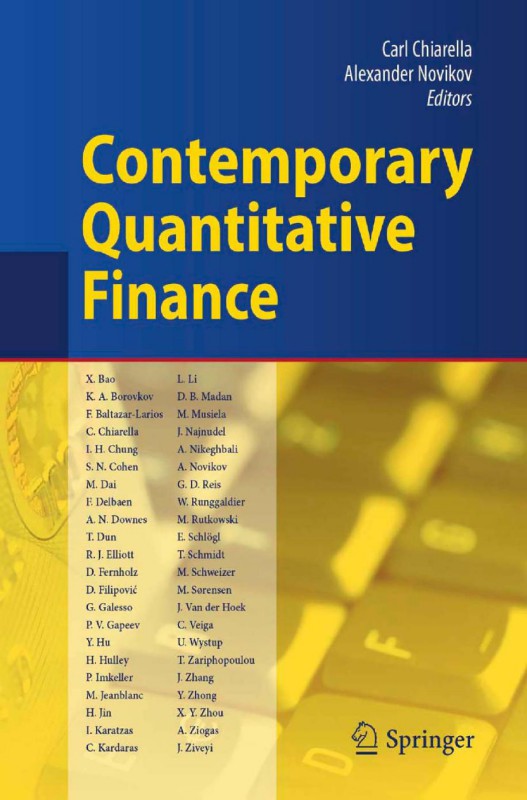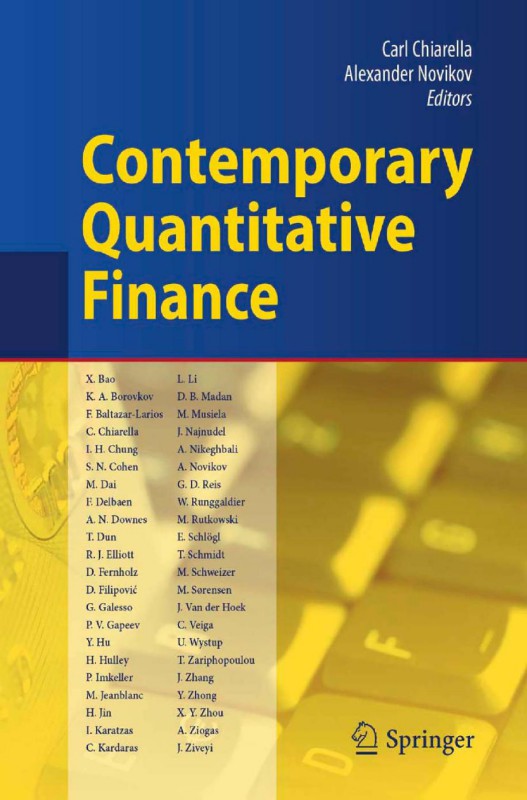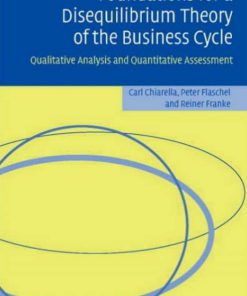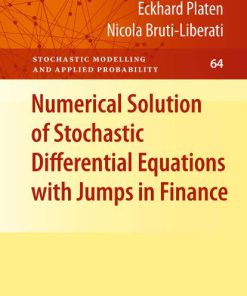Contemporary Quantitative Finance Essays in Honour of Eckhard Platen 1st Edition by Carl Chiarella, Alexander Novikov 3642034780 9783642034787
$50.00 Original price was: $50.00.$25.00Current price is: $25.00.
Authors:Carl Chiarella, Alexander Novikov , Series:Management [655] , Author sort:Carl Chiarella, Alexander Novikov , Languages:Languages:eng , Published:Published:Jul 2010 , Publisher:Springer
Contemporary Quantitative Finance Essays in Honour of Eckhard Platen 1st Edition by Carl Chiarella, Alexander Novikov – Ebook PDF Instant Download/Delivery. 3642034780, 9783642034787
Full download Contemporary Quantitative Finance Essays in Honour of Eckhard Platen 1st Edition after payment

Product details:
ISBN 10: 3642034780
ISBN 13: 9783642034787
Author: Carl Chiarella, Alexander Novikov
This volume contains a collection of papers dedicated to Professor Eckhard Platen to celebrate his 60th birthday, which occurred in 2009. The contributions have been written by a number of his colleagues and co-authors. All papers have been – viewed and presented as keynote talks at the international conference “Quantitative Methods in Finance” (QMF) in Sydney in December 2009. The QMF Conference Series was initiated by Eckhard Platen in 1993 when he was at the Australian – tional University (ANU) in Canberra. Since joining UTS in 1997 the conference came to be organised on a much larger scale and has grown to become a signi?cant international event in quantitative ?nance. Professor Platen has held the Chair of Quantitative Finance at the University of Technology, Sydney (UTS) jointly in the Faculties of Business and Science since 1997. Prior to this appointment, he was the Founding Head of the Centre for Fin- cial Mathematics at the Institute of Advanced Studies at ANU, a position to which he was appointed in 1994. Eckhard completed a PhD in Mathematics at the Technical University in Dresden in 1975 and in 1985 obtained his Doctor of Science degree (Habilitation degree in the German system) from the Academy of Sciences in Berlin where he headed the Stochastics group at the Weierstrass Institute.
Contemporary Quantitative Finance Essays in Honour of Eckhard Platen 1st Table of contents:
Introduction
Preliminaries
Change of Variables
The Model
Numéraire and Log-Optimality Properties
Relative Arbitrage
The Föllmer “Exit Measure”
The Functionally-Generated Portfolio
Induced Drifts
Conditioning
Numéraire and Log-Optimality Properties of pi (·)
Relative Entropy
Stochastic Control
Stochastic Game
Conclusion
References
Finitely Additive Probabilities and the Fundamental Theorem of Asset Pricing
Introduction
Arbitrages of the First Kind and Weakly Equivalent Local Martingale Measures
General Probabilistic Remarks
The Market and Investing
Arbitrages of the First Kind
Weakly Equivalent Local Martingale Measures
Local Probabilities Weakly Equivalent to P
Density Processes
Local Martingales
Weakly Equivalent Local Martingale Measures
The Main Result
The FTAP of Delbaen and Schachermayer
Proving the FTAP
NFLVR and the Supermartingale Property of Wealth Processes Under a WELMM
The Case of Continuous-Path Semimartingales
References
M6-On Minimal Market Models and Minimal Martingale Measures
Introduction
General Financial Market Models
Continuous Financial Market Models
Minimal Market Models
References
The Economic Plausibility of Strict Local Martingales in Financial Modelling
Introduction
An Overview of the Two Models
The Stock Price Bubble
The Bond Price Bubble
References
A Remarkable sigma-finite Measure Associated with Last Passage Times and Penalisation Problems
Notation
Introduction
A New Kind of Augmentation of Filtrations Consistent with the Problem of Extension of Measures
Understanding the Problem
The N-usual Augmentation
Extension of Measures and the N-usual Augmentation
A Universal sigma-finite Measure Q
The Class (Sigma)
A Special Case Related to Financial Modeling
The General Case
Further Properties of Q and Some Remarkable Associated Martingales, and Penalisation Results
References
Pricing Without Equivalent Martingale Measures Under Complete and Incomplete Observation
Introduction
The Model
Relative Arbitrage and Absence of Martingale Measures
Pricing Under Absence of an Equivalent Martingale Measure (the Case of Complete Observation)
The “Fernholz-Karatzas Approach”
The “Benchmark Approach” of Platen
Equivalence of the Two Pricing Approaches
Pricing Under Absence of an Equivalent Martingale Measure (the Case of Incomplete Observation)
The Model
Corresponding Complete Observation Model
Price Dynamics
GOP Dynamics
GOP Strategy and Growth Rate Under Complete and Incomplete Observation
Expected Utility Maximization Under Complete and Incomplete Observation
Pricing According to the “Fernholz-Karatzas Approach”
First Variant
Second Variant
Pricing According Platen’s “Benchmark Approach”
Comments on the Equivalence of the Two Approaches in the Case of Incomplete Observations
References
Existence and Non-uniqueness of Solutions for BSDE
Notation
A Convergence Result
Pathwise Subquadratic Drivers
The Relation with Minimal Elements
An Example
References
Comparison Theorems for Finite State Backward Stochastic Differential Equations
Introduction
A Mathematical Setting
Some Lemmas
Linear BSDEs
A Scalar Comparison Theorem
General Comparison Theorems
F-Expectations
Applications to Risk Measures
References
Results on Numerics for FBSDE with Drivers of Quadratic Growth
Introduction
Preliminaries
Pricing and Hedging with Correlated Assets
Smoothness and Path Regularity Results
Smoothness Results
Regularity and Bounds for the Solution Process
A Truncation Procedure
The Exponential Transformation Method
Back to the Pricing Problem
Some Results on BMO Martingales
Basics of Malliavin’s Calculus
Some Results on SDE
Path Regularity for Lipschitz FBSDE
References
Variance Swap Portfolio Theory
Introduction
Autocorrelation and the Hardy Littlewood Gauss Transform
NonGaussian Dependence Model
Variance Swap Fixed Leg Pricing
Optimization Criterion and Portfolio Design
Results on Portfolio Design
Conclusion
References
Stochastic Partial Differential Equations and Portfolio Choice
Introduction
The Investment Model
The Backward Formulation of the Portfolio Choice Problem and the Associated SPDE
Examples: Markovian Stochastic Factor Models
Single Stochastic Factor Models
The CRRA Case: uT(x) = 1gamma xgamma, 0<gamma<1, gamma0
The Logarithmic Case: uT(x) =lnx, x>0
Multi-stochastic Factor Models
The Forward Formulation of the Portfolio Choice Problem and the Associated SPDE
Stochastic Optimization and Forward Investment Performance Process
Examples
The Case of Zero Volatility: a(x,t) 0
Single Stochastic Factor Models
Cases of Non-zero Volatility
The Market View Case: a(x,t) = U(x,t) phit
The Benchmark Case: a(x,t) = xUx (x,t) deltat
The Combined Market View/Benchmark Case: a (x,t) = -xUx (x,t) deltat + U (x,t) phit
Single Stochastic Factor Models
References
Issuers’ Commitments Would Add More Value than Any Rating Scheme Could Ever Do
Introduction
Rating Schemes
Floor
Conclusion
References
Pricing and Hedging of CDOs: A Top Down Approach
Introduction
(T,x)-Bond Dynamics
(T,x)-Forward Rates
Relation to the Top-Down Model in Lipton-Shelton 13.lipshe09
Single Tranche CDOs (STCDOs)
Variance-Minimizing Hedging
Deterministic Risk Free Rates
Affine Term Structure
Proof of Proposition 1
Conclusion and Outlook
References
Constructing Random Times with Given Survival Processes and Applications to Valuation of Credit Deri
Introduction
Filtering Example
Azéma Supermartingale
Conditional Distributions
Preliminary Results
Properties of (P,G)-Martingales
Girsanov’s Theorem
Construction Through a Change of Measure
Case of the Brownian Filtration
Applications to Valuation of Credit Derivatives
Defaultable Zero-Coupon Bonds
Credit Default Swaps
References
Representation of American Option Prices Under Heston Stochastic Volatility Dynamics Using Integral
Introduction
Problem Statement – the Heston Model
Finding the Density Function Using Integral Transforms
Solution for the American Call Option
Conclusion
Deriving the Jamshidian Formulation Under Stochastic Volatility
Proof of Proposition 1
Proof of Proposition 3
Proof of Proposition 4
Proof of Proposition 5 – The Inverse Laplace Transform
Proof of Proposition 8 – The European Option Price
Proof of Proposition 9
The Evaluation of Some Complex Integral Terms Occurring in Appendices 6 and 7
References
Buy Low and Sell High
Introduction
Preliminaries
Buying Problems
Selling Problems
Optimal Buying and Selling Strategies
Buying Strategies
Selling Problems
Concluding Remarks
Appendix: Proofs
Some Transformations
Proof of Theorem 1
Proof of Theorem 2
Proof of Theorem 3
References
Continuity Theorems in Boundary Crossing Problems for Diffusion Processes
Introduction
Approximation Rates in the Brownian Motion Case
Approximation Rates for General Diffusions
Differentiability of the Boundary Crossing Probabilities
References
Binomial Models for Interest Rates
The Methodology
The Weak Solution in Continuous Time
The Approximation of the Weak Solution
The Black and Scholes Model
One Factor Interest Rate Models
The Hull and White One-factor Model
A Black-Karasinsky Type Model
Cox, Ingersoll and Ross Model
Two Factor Interest Rate Models
The Brennan-Schwartz Two-factor Model
The Hull-White Two-factor Model
Conclusions
Appendix
References
Lognormal Forward Market Model (LFM) Volatility Function Approximation
Introduction
Generic Forward Rates
Base Definitions
Generic Forward Rate Definition
Interpolation by Day-Count Fractions
Caplet Volatility
Ito Calculus
Step 1
Step 2: Derivation of nuX
Step 3: Derivation of nuY
Step 4
Non-standard Forward SDE
Volatility Approximation
Dead Rate Volatility
Caplet Volatility
LFM Convexity Adjustment
Swaption Volatility Calculation
Definition
Approximate Swaption Volatility Formula
Testing the Approximate Formulae
Assumptions and Descriptions for Performance Tests
Conclusion
Appendix
Quotient SDE
Modified Black’s Formula
Step 1
Step 2
References
Maximum Likelihood Estimation for Integrated Diffusion Processes
Introduction
Model and Data
The Likelihood Function and the EM-Algorithm
Likelihood with Full Diffusion Observation
EM Algorithm
Conditional Diffusion Process Simulation
The Ornstein-Uhlenbeck Process: A Simulation Study
The Likelihood and the EM-algorithm
A Simulation Study
The CIR Process and a Stochastic Volatility Model
The Likelihood and the EM-algorithm
A Simulation Study
Concluding Remarks
References
People also search for Contemporary Quantitative Finance Essays in Honour of Eckhard Platen 1st:
quantitative finance questions
undergraduate quantitative finance programs
trends in quantitative finance
quantitative finance textbook
You may also like…
eBook PDF
Gaming Essays On Algorithmic Culture 1st edition by Alexander Galloway 0816648514 978-0816648511












